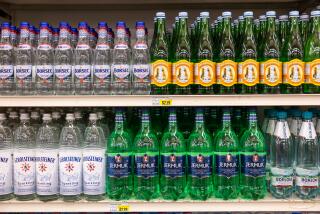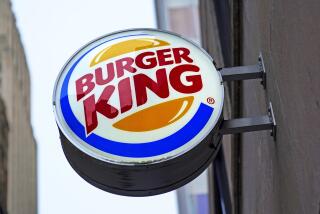Getting Fresh : Controversy: Some orange-juice makers are feeling a squeeze because an ad for Citrus Hill Fresh Choice criticizes their blends.
- Share via
“Just look at the difference between a just-picked orange and one that sat around a couple of days. Something magical is gone. That’s why Citrus Hill Fresh Choice is picked and squeezed within a day . . . to keep that freshness alive.”
The controversy this TV commercial started when it first ran last spring is still unresolved. Procter & Gamble, which makes the juice, and a host of critics are still embroiled in a squabble about the advertising and labeling of the product.
Critics are concerned about the advertising of Citrus Hill Fresh Choice because it promotes the oranges as being picked and squeezed on the same day and denigrates oranges that “sat around a couple of days.”
Last fall the Florida Citrus Commission wrote a letter to Procter & Gamble expressing several concerns; one was that the ads would make consumers think that some processors use “old, inferior, possibly unwholesome fruit” in their products.
Kathy Clay, spokeswoman for the commission, said that most processors pick and squeeze their oranges within two days and questioned the difference a day makes.
The longer a piece of fruit is away from the tree, the more likely there will be dehydration. However, said Clay, “That generally takes more than one day. We’re talking about several weeks.”
In addition, Clay questioned how Procter & Gamble could ensure that all of its oranges are picked and squeezed within a day, particularly since some of the concentrate is imported from Brazil. (Like other processors, Procter & Gamble imports frozen concentrate, since Florida frosts have severely crippled domestic supplies during the past decade.)
Wendy Jacques, spokeswoman for Procter & Gamble, said, “We’ve improved our manufacturing process to the point where the vast majority of oranges are picked and squeezed within 24 hours.”
There are probably some that are squeezed after 24 hours, Jacques admitted, but she said “the vast majority” are squeezed well within that time. Jacques said that when the manufacturing process was improved, the changes were made in both the United States and Brazil and added, “We are consistently monitoring all processing operations to ensure those standards are being met.”
Regardless of the fact that the juice is accented with orange oils and essence to enhance its flavor and then frozen into concentrate, Jacques said that Procter & Gamble believes that oranges that are picked and squeezed in a day provide juice that tastes fresher.
Recently, in response to its complaint letter, the Florida Citrus Commission received a reply from Procter & Gamble saying that the advertising does not refer to any competitors but simply “reflects the way we process oranges.”
Nonetheless, Procter & Gamble said, although it has not removed the reference, it has “substantially de-emphasized” the visualization of an orange that is more than a day old.
Another big issue is the use of the term fresh in the name of the product. Citrus Hill Fresh Choice, which is reconstituted from frozen concentrate, is sold in cartons in the refrigerated section of supermarkets.
“With Citrus Hill sitting in the refrigerator next to the juice that the produce guy has just squeezed, people will be legitimately deceived into thinking it (Citrus Hill) is fresh,” said Steve Gardner, assistant attorney general for Texas.
And although the words from concentrate do appear on the label, the print is orange--as is the carton. “The orange on orange is not very prominent,” said Betsy Woodward, chief of the food laboratory of the Florida Department of Agriculture and Consumer Services. “The total picture gives the impression that this is a fresh product when it is not.”
Jacques said that when Procter & Gamble changed the name of the product from Citrus Hill Select last spring, it carefully reviewed all the regulatory and legal requirements. “We believe that Citrus Hill Fresh Choice conforms with all requirements,” Jacques said.
What’s more, Jacques added, the company’s market research found no difference in consumer understanding of what the product was whether it was called Fresh Choice or Select.
In 1989, before Procter & Gamble renamed and repackaged its product, Citrus Hill was a firm third in orange-juice sales, trailing No. 1 Tropicana and second-place Minute Maid by a substantial gap, according to Beverage Marketing Corp., a New York-based market research and consulting firm.
Competitors are concerned that Procter & Gamble is confusing the orange-juice category and attempting to “leapfrog” the premium products, according to Harris Cutler, general counsel of Coca-Cola Foods, owner of Minute Maid.
Minute Maid Premium Choice is one of a growing number of premium orange juices that are pasteurized but not made from concentrate. They are also sold in the refrigerated section of grocery stores.
“If frozen concentrate can be called fresh, what in the category is not fresh? What does that do to companies that want to come out with a fresh-squeezed or a pasteurized brand? Do you join and call everything fresh?” asked Cutler.
In fact, Procter & Gamble has cast that answer in a different light to defend its use of the name Fresh Choice. “There are dozens of other juices and juice beverages using the word fresh in their brand name,” said Jacques. “We believe it’s unfair for our brand to be singled out and thrust into this controversy. We will vigorously defend our position.”
But Gardner doesn’t buy this defense. “It’s sad that industry leaders like Procter & Gamble would go along with the crowd and use that as an excuse for deception,” he said. “The big guys set the standards. Those are the guys who deserve to be gone after.”
Gardner compared the situation to his childhood, when he wanted to do something against parental wishes. The argument he’d use was always: “But Daddy, all the other kids’ dads let them do it.”
The debate over the use of the word fresh is the latest in a series of “fresh” claims made by manufacturers on product labels and in advertisements.
Of continuing controversy is Ragu Foods Inc.’s Fresh Italian, a line of bottled pasta sauces. Last April the Food and Drug Administration cited the Connecticut-based company for six violations in connection with the Fresh Italian line. The state of Texas also threatened to impound the product unless appropriate label changes were made.
Current FDA compliance guidelines prohibit the use of the word fresh to describe foods that have been subject to any form of chemical or heat processing. Bottled tomato sauces undergo heat processing.
At the time, Ragu Foods acknowledged that its sauce is heat-processed but denied that the label was misleading. A spokeswoman for the company said that the term fresh is part of the product’s trade name, which the company believed exempted it from the government’s policy regarding heat-processed foods.
Although the company does not believe its original label was violative, Ragu did agree to modify it. The product is now called Ragu Fresh Italian Brand pasta sauce, and the qualifier “means fresh taste” appears near the name. The changes were accepted by the state of Texas but not by the FDA.
Still, critics are getting impatient with the FDA’s apparent inability to enforce the law. Although the agency did cite Ragu for “false and misleading” labeling, it has not taken any further action against the company. Agency officials have met with Procter & Gamble, but no formal action, such as sending a warning letter, has been taken.
“If the FDA is going to show us it’s an effective agency, it should follow up on its threats,” said Linda Golodner, executive director of the National Consumers League.
FDA spokesman Chris Lecos denied that the agency is “dragging its feet.” Lecos said that FDA will most likely be officially defining the term fresh as part of the agency’s new nutrition-labeling law, which Congress passed last fall. Part of the law requires FDA to define label descriptors such as light, high and low.
More to Read
Inside the business of entertainment
The Wide Shot brings you news, analysis and insights on everything from streaming wars to production — and what it all means for the future.
You may occasionally receive promotional content from the Los Angeles Times.










